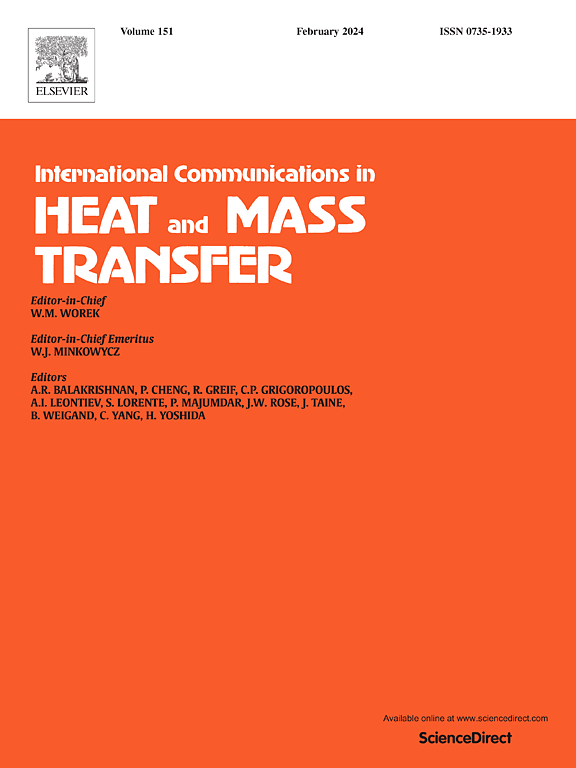具有移动接触线和可溶性表面活性剂的两相流的二阶相场-晶格玻尔兹曼模型
IF 6.4
2区 工程技术
Q1 MECHANICS
International Communications in Heat and Mass Transfer
Pub Date : 2025-05-21
DOI:10.1016/j.icheatmasstransfer.2025.109104
引用次数: 0
摘要
本文建立了具有移动接触线和可溶表面活性剂的两相流的二阶相场-晶格玻尔兹曼模型。相场和表面活性剂浓度场由二阶保守的Allen-Cahn方程控制,流场由基于速度的Navier-Stokes方程描述。该模型保证了表面活性剂浓度的变化不影响阶参数分布,避免了锐化效应。由Gibbs-Duhem方程导出的近似显式状态方程定义了表面活性剂浓度与界面张力之间的关系,并将其纳入杨氏方程以确定平衡接触角。几何定义的润湿边界条件解决了移动接触线问题。模型验证包括利用拉普拉斯定律验证状态方程和基于液滴在平面上扩散的几何特性评估平衡接触角。模拟研究了润湿性、表面活性剂浓度和流动参数对液滴动力学的影响,包括Couette和Poiseuille流动、重力驱动的液滴运动以及液滴在粗糙表面上的行为。研究结果表明,表面活性剂浓度的增加使亲水性表面的接触角减小,疏水性表面的接触角增大,对表面润湿性的影响突出。本文章由计算机程序翻译,如有差异,请以英文原文为准。
A second-order phase field-lattice Boltzmann model for two-phase flows with moving contact line and soluble surfactants
This paper presents a second-order phase field-lattice Boltzmann model for two-phase flows with moving contact lines and soluble surfactants. The phase field and surfactant concentration field are governed by second-order conservative Allen-Cahn equations, while the velocity-based Navier–Stokes equations describe the flow field. The model ensures that surfactant concentration variations do not affect the order parameter distribution, preventing sharpening effects. An approximate explicit equation of state, derived from the Gibbs–Duhem equation, defines the relationship between surfactant concentration and interfacial tension, which is incorporated into Young's equation to determine the equilibrium contact angle. A geometrically defined wetting boundary condition addresses the moving contact line problem. Model validation includes verifying the equation of state using the Laplace law and assessing the equilibrium contact angle based on the geometric properties of droplets spreading on planar surfaces. Simulations explore the effects of wettability, surfactant concentration, and flow parameters on droplet dynamics, including Couette and Poiseuille flows, gravity-driven droplet motion, and droplet behavior on rough surfaces. The study results indicate that increasing surfactant concentration reduces the contact angle on hydrophilic surfaces while increasing it on hydrophobic surfaces, highlighting its impact on surface wettability.
求助全文
通过发布文献求助,成功后即可免费获取论文全文。
去求助
来源期刊
CiteScore
11.00
自引率
10.00%
发文量
648
审稿时长
32 days
期刊介绍:
International Communications in Heat and Mass Transfer serves as a world forum for the rapid dissemination of new ideas, new measurement techniques, preliminary findings of ongoing investigations, discussions, and criticisms in the field of heat and mass transfer. Two types of manuscript will be considered for publication: communications (short reports of new work or discussions of work which has already been published) and summaries (abstracts of reports, theses or manuscripts which are too long for publication in full). Together with its companion publication, International Journal of Heat and Mass Transfer, with which it shares the same Board of Editors, this journal is read by research workers and engineers throughout the world.

 求助内容:
求助内容: 应助结果提醒方式:
应助结果提醒方式:


